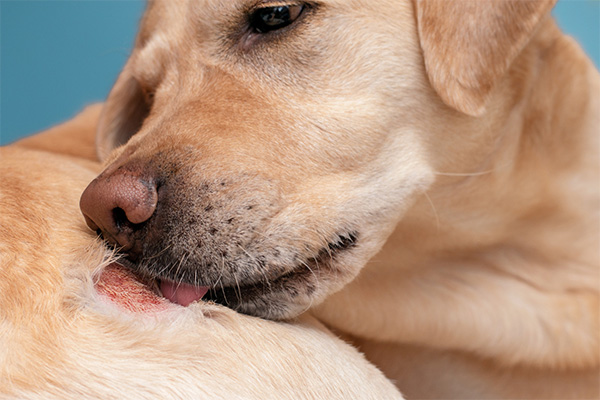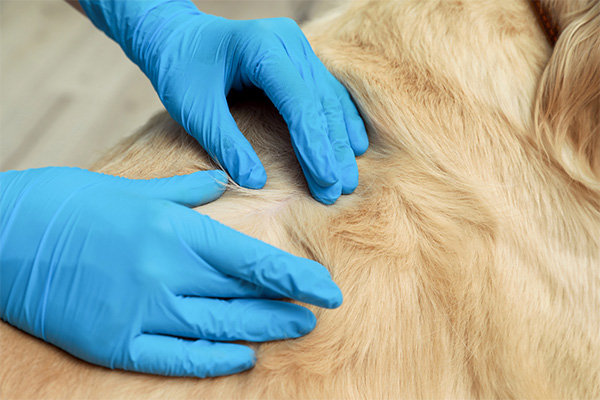As a devoted dog owner, the well-being of your furry companion is always at the forefront of your mind. When it comes to health concerns, one ailment that often perplexes and worries pet parents is the onset of "hot spots" on their beloved canines. These skin irritations, medically known as acute moist dermatitis, can emerge seemingly out of nowhere, causing discomfort and distress to both the dog and the owner.
Understanding hot spots is crucial for any responsible dog owner. These lesions are not just a cosmetic issue but a sign of underlying problems that need immediate attention. The condition typically manifests as red, moist, irritated, and sometimes oozing skin, often accompanied by intense itching and discomfort. In their attempt to soothe the itch, dogs might lick, bite, or scratch the affected area, potentially exacerbating the problem.
So, what causes these distressing hot spots? In this comprehensive guide, we dive into the causes, symptoms, and effective treatments for hot spots, providing you with the essential knowledge and practical tips to safeguard your dog's health and happiness.
What Is a Dog Hot Spot?
A dog hot spot, or acute moist dermatitis, is a common yet often misunderstood condition affecting canines. Manifesting as a red, irritated, and sometimes oozing patch on the skin, it causes significant discomfort. These lesions, triggered by factors like allergies, poor grooming, or even stress, demand prompt attention.
Symptoms Of dog hot spot
Dog hot spots are characterized by various symptoms that can vary in severity. Here are the key symptoms to look out for:
- Red, Inflamed Skin
- Itching and Pain
- Hair Loss
- Oozing or Crusting
- Bad Odor
- Swelling
- Changes in Behavior
It's important to consult a veterinarian if you notice any of these symptoms in your dog, as timely and appropriate treatment is crucial in preventing further infection and promoting healing.

Cause Of Dogs Hot Spots
Dog hot spots can be caused by various factors, often involving an initial irritation that prompts the dog to scratch, lick, or bite the area, leading to further inflammation and infection. Before treating hot spots on dogs, it's essential to identify the cause. Common causes include:
- Allergies
- Insect Bites: Bites from fleas, mites, or other insects can irritate the skin and start the cycle of scratching and licking.
- Poor Grooming
- Ear or Skin Infections
- Stress or Boredom
- Anal Gland Issues
- Habitual Behavior: Some dogs develop a habit of licking certain areas of the dog's body, which can lead to skin irritation and hot spots.
- Moisture: Hot spots can develop when the skin remains wet for a long time, such as after swimming or bathing, especially in breeds with dense undercoats.
- Trauma or Skin Wounds
How are Dog Hot Spots Diagnosed
Diagnosing dog hot spots, or acute moist dermatitis, typically involves a combination of clinical examination and a detailed medical history. This is the typical diagnostic approach employed by veterinarians to identify hot spots in dogs:
- Physical Examination: The veterinarian initiates the diagnostic process by conducting a comprehensive examination of the affected area to evaluate the extent of the hot spot's severity. They'll look for signs of redness, inflammation, infection, and any other skin abnormalities.
- Medical History Review: Understanding the dog's medical history, including any previous occurrences of skin issues, allergies, or behavioral problems, is crucial. The vet will also ask about recent activities (like swimming or grooming) that might have contributed to the condition.
- Allergy Testing: If allergies are suspected as an underlying cause, the veterinarian may suggest allergy testing as part of the diagnostic process. This can help identify specific allergens that are causing the skin irritation.
- Skin Scraping or Culture: To rule out other skin conditions like mange or fungal infections, the vet may perform a skin scraping or culture. This entails gathering a small sample of skin cells or discharge for microscopic examination or bacterial culture.
- Blood Tests: In certain instances, particularly when an underlying systemic condition is suspected, the veterinarian may conduct blood tests to evaluate the dog's overall health.
- Assessment of Grooming and Diet: Vets often inquire about the dog's grooming routine and diet, as these can play a role in skin health.
- Behavioral Assessment: Since behavioral issues like anxiety or boredom can lead to excessive licking or scratching, the vet might assess the dog's behavior and environment.
Diagnosing hot spots is generally straightforward, but determining the underlying cause can be more complex and require a multifaceted approach.

How To Treat Hot Spots On Dogs
Treating dog hot spots may involve a multifaceted approach aimed at healing the affected skin, alleviating discomfort, and addressing underlying causes. Here's a typical treatment plan to treat dog hot spots:
- Cleaning and Clipping: The affected area is usually clipped and cleaned to allow air to reach the skin and facilitate the application of topical treatments. Additionally, such tests aid in monitoring the healing process.
- Topical Medications: Veterinarians often prescribe topical treatments, including medicated shampoos, ointments, sprays, or creams. These medications usually comprise ingredients that alleviate skin irritation, diminish inflammation, and address bacterial or fungal infections.
- Oral Medications: Depending on the severity and cause of the hot spot, oral medications such as antibiotics (for bacterial infections), antifungals (for yeast infections), or steroids (to reduce inflammation and itching) may be prescribed.
- Pain Relief: If the hot spot is particularly painful, the vet may prescribe pain relief medication to make the dog more comfortable during the healing process.
- E-Collars or Protective Gear: To prevent the dog from licking, biting, or scratching the affected area, the veterinarian may suggest using an Elizabethan collar (E-collar) or other protective gear.
- Allergy Management: If allergies are identified as a cause, specific treatments like antihistamines, allergy shots, or changes in diet might be necessary.
- Behavioral Therapy: For hot spots caused by behavioral issues like anxiety or stress, behavioral modification techniques or therapy may be recommended.
- Improving Grooming and Hygiene: Regular grooming and maintaining good hygiene can prevent future occurrences, especially in breeds with dense fur or those prone to skin issues.
- Environmental Adjustments: Making changes to the dog's environment, such as using hypoallergenic bedding or removing potential allergens, can also be helpful.
Adhering closely to the veterinarian's instructions is crucial, and completing the full course of any prescribed medication is essential, even if the hot spot seems to be improving before the treatment is completed. This practice ensures thorough healing and minimizes the risk of recurrence.
How to Prevent Hot Spots On Dogs
Preventing hot spots on dogs or their recurrence involves a combination of good grooming, proper health care, and attention to your dog's overall well-being. Here are some effective strategies:
Regular Grooming
Regularly brush and groom your dog to prevent fur matting, especially in long-haired breeds. Matted fur can trap moisture and debris, creating an ideal environment for developing hot spots.
Keep Your Dog Dry
After bathing, swimming, or walking in wet conditions, thoroughly dry your dog, especially around the ears and under the tail. Moisture is a key factor in the development of hot spots.
Flea and Tick Prevention
Utilize flea and tick preventatives consistently, as these parasites can induce itching and scratching, potentially resulting in the development of hot spots.
Allergy Management
Work with your vet to manage your dog's allergies effectively. This may encompass diet alterations, medication administration, or other recommended treatments.
Healthy Diet
Feed your dog a balanced diet to support skin health. Omega-3 fatty acids, found in fish oils, can be particularly beneficial for maintaining healthy skin and help promote a healthy skin barrier.
Promptly Address Ear and Skin Infections
Since these can lead to scratching and licking, which in turn can cause hot spots, treating any ear or skin infections promptly is important.
Stress Reduction
Stress can lead to excessive licking and scratching. Provide a calm environment for your dog, and consider behavioral therapy or calming products if your dog is prone to anxiety.
Regular Health Check-Ups
Regular visits to the vet can help catch and address any underlying health issues before they lead to hot spots.
Avoid Irritants
Ensure your dog is protected from potential irritants that could trigger itching or skin reactions. This includes certain plants, garden chemicals, or household cleaners.
Monitoring and Early Intervention
Monitor both your dog's skin condition and behavior closely. If you notice excessive licking, scratching, or any changes in the skin, address it promptly before it develops into a full-blown hot spot.

FAQS
When should I see a vet for a hot spot?
If the hot spot is rapidly worsening, very painful, showing signs of infection (pus, bad smell), or if the dog seems lethargic or unwell, it's important to see a vet promptly. Additionally, professional veterinary care is recommended if home treatments don't improve the condition within a couple of days.
Do certain breeds of dogs get hot spots more often?
Yes, some breeds, especially those with thick coats, long hair, or those prone to allergies or ear infections, are more susceptible to developing hot spots. Nonetheless, it is advisable to seek guidance from a veterinarian for appropriate treatment.
How do you treat a hot spot at home?
Clean the area with mild, non-irritating antiseptic solutions, apply over-the-counter hydrocortisone sprays or creams to reduce itching, and keep the dog from licking or biting the spot using an E-collar. However, it is recommended to seek the advice of a veterinarian for proper treatment.
Is a dog's hot spot contagious to other pets or humans?
Hot spots are not contagious to other pets or humans. Yet, it's important to note that the root cause of the hot spot, such as a fungal or bacterial infection, might potentially be contagious.
